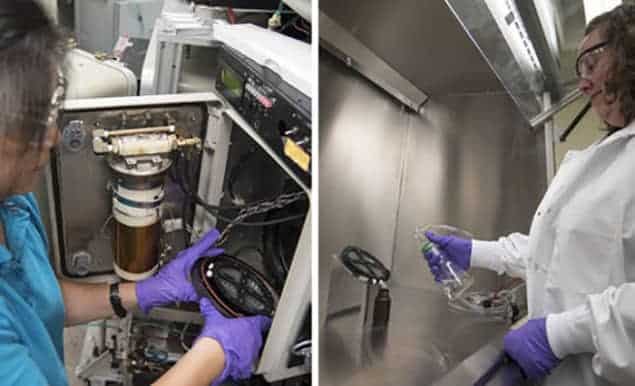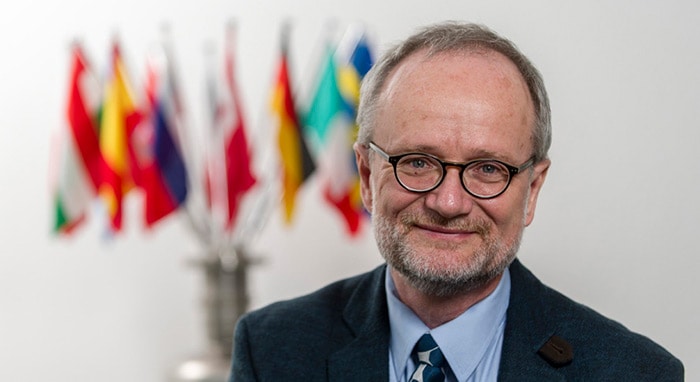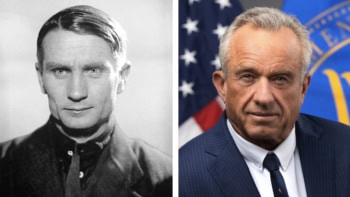Flash Physics is our daily pick of the latest need-to-know developments from the global physics community selected by Physics World‘s team of editors and reporters

Weather nanoparticle-infused coatings to study ecological impact
In an attempt to study the ecological and health-related consequences of nanoparticles released into the environment, researchers at the National Institute of Standards and Technology (NIST) have subjected a commercial nanoparticle-infused coating to a weathering process. The technique offers an accelerated way to study the effects of weathering from ultraviolet radiation as well as simulated rainwater. To study the effects of weathering, the team exposed multiple samples of a commercially available polyurethane coating containing silicon-dioxide nanoparticles to intense UV radiation for 100 days inside the NIST SPHERE (Simulated Photodegradation via High-Energy Radiant Exposure) – one day inside the SPHERE was equivalent to 10 to 15 days outdoors. For the “NIST simulated rain,” the researchers used filtered water that was converted into tiny droplets, sprayed under pressure onto the individual samples, and then the run-off – with any loose nanoparticles – was collected in a bottle. The team found that humidity and exposure time are contributing factors for nanoparticle release, which may be useful in designing future studies to determine potential biological impacts. The research is published in the Journal of Coatings Technology and Research.
Alice keeps a secret for 24 hours
Information encoded into an optical signal has been kept secret for 24 hours by a team of physicists at the University of Geneva in Switzerland. The work is a demonstration of the “bit-commitment” protocol whereby one party (Alice) creates a binary number and keeps it secret from the world until an agreed time when it is revealed to another party (Bob). An important feature of the protocol is that Bob can verify that the value of the number has not been tampered with while it was being kept secret. The process involves Alice and Bob each having two agents that they alone control. Alice’s secret number is mixed with a series of random numbers, with the results exchanged back and forth between the agents. The encryption algorithm is such that Bob can only determine the value of Alice’s secret after the final round of exchanges is complete – and he can also work out if anyone has clandestinely changed its value. Last year, several members of the Geneva team managed to keep Alice’s secret for 2 ms by performing six information exchanges over 131 km of fibre. Now, Anthony Martin and colleagues have boosted that time to 24 h. While the separation between parties was shorter in this latest work (7 km), they achieved five billion exchanges of information over the 24 hour period. The team points out that it could extend this time to a year using a 10,000 km separation. The research is described in Physical Review Letters, and one possible application is tamper-proof voting, whereby a ballot could be kept secret until it was time to count
European XFEL appoints new chairperson

Physicist Robert Feidenhans’l has been appointed chairperson of the management board of the European X-ray Free Electron Laser (XFEL). The research facility is currently being built in Hamburg, Germany, and when complete next year it will generate X-ray beams 30,000 times per second, with each pulse lasting less than 100 fs (10–13 s) that will allow researchers to create “movies” of processes such as chemical bonding and vibrational energy flow across materials. The facility’s management board has five members including the chairperson, an administrative director, as well as three scientific directors. Feidenhans’l, 58, is currently head of the Niels Bohr Institute at the University of Copenhagen, Denmark, and will join the European XFEL on 1 January 2017. He will succeed Massimo Altarelli, who has been at the head of the board since it was founded in 2009, and will now retire. “I am delighted to see the European XFEL, to which I devoted all my efforts over many years, in excellent hands,” says Altarelli, adding that Feidenhans’l is “an eminent X-ray scientist, with huge prestige in the scientific community and with vast experience in the management of large research organizations, including international ones. I am sure he will lead the facility to outstanding success in its operation phase”.
- You can find all our daily Flash Physics posts in the website’s news section, as well as on Twitter and Facebook using #FlashPhysics. Tune in to physicsworld.com later today to read today’s extensive news story on the optical behaviour of electrons in graphene.



